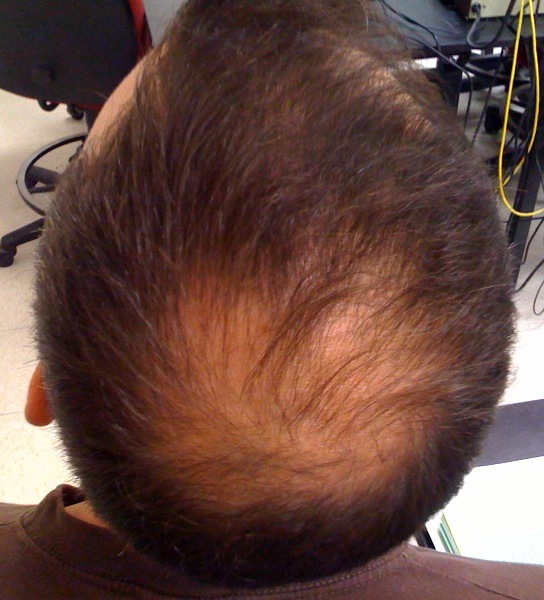
Image: "Alopecia" is licensed under CC BY-SA 3.0.
Male Alopecia (Male Pattern Hair Loss)
Introduction | Aetiology and Pathophysiology | Clinical Presentation | Diagnosis | Management and Treatment | When to Refer | References
Introduction
Male alopecia, also known as male pattern hair loss (androgenetic alopecia), is the most common form of hair loss in men. It is a progressive condition characterised by a receding hairline and thinning of hair on the crown and temples. This type of hair loss is largely determined by genetic and hormonal factors and can begin as early as the late teens or early twenties.
Aetiology and Pathophysiology
Male pattern hair loss is primarily driven by a combination of genetic predisposition and the influence of androgens (male hormones):
- Genetics: A strong genetic component exists, with the condition often running in families. The inheritance pattern is polygenic, meaning it involves multiple genes.
- Androgens: Dihydrotestosterone (DHT), a derivative of testosterone, plays a key role in male pattern hair loss. DHT binds to androgen receptors in hair follicles, leading to the miniaturisation of hair follicles and a shortened anagen (growth) phase, resulting in thinner and shorter hairs.
Clinical Presentation
The typical presentation of male pattern hair loss includes:
- Receding Hairline: The hairline recedes gradually from the forehead, forming an "M" shape. This is often one of the earliest signs of male pattern baldness.
- Thinning at the Crown: Thinning of the hair at the crown of the head is another common feature. Over time, the thinning area can expand.
- Progression: The condition progresses over time, with the areas of thinning potentially merging, leading to more extensive baldness. In severe cases, only a rim of hair remains at the back and sides of the head (the "horseshoe" pattern).
- No Scarring: Male pattern hair loss is non-scarring, meaning the hair follicles remain intact and potentially responsive to treatment.
Diagnosis
The diagnosis of male pattern hair loss is primarily clinical, based on the characteristic pattern of hair loss and patient history. Key points in diagnosis include:
- History: A detailed history should include the age of onset, family history of hair loss, and the rate of progression.
- Physical Examination: Examination should focus on the pattern of hair loss, hair shaft thickness, and the presence of miniaturised hairs. The hair pull test may be performed to assess active shedding.
- Differential Diagnosis: Other causes of hair loss, such as telogen effluvium, alopecia areata, or scarring alopecia, should be considered and ruled out based on history and examination.
- Blood Tests: Certain blood tests may be requested to rule out other causes of hair loss:
- Full Blood Count (FBC): To check for anaemia or other haematological conditions that might contribute to hair loss.
- Thyroid Function Tests (TFTs): To rule out thyroid dysfunction, as both hyperthyroidism and hypothyroidism can lead to hair loss.
- Ferritin Levels: To assess iron stores, as low ferritin can be associated with hair thinning.
- Hormone Profile: Including testosterone and DHT levels, especially in cases where an androgenic cause is suspected or if the patient has other symptoms of hormonal imbalance.
Management and Treatment
Management of male pattern hair loss focuses on slowing progression, promoting regrowth, and addressing cosmetic concerns. Treatment options include over-the-counter and prescription therapies:
1. Over-the-Counter Treatments
- Minoxidil (Regaine): Minoxidil 5% is available over the counter as a topical solution or foam (marketed as Regaine in the UK). It is applied directly to the scalp and works by prolonging the anagen phase of hair growth and increasing blood flow to hair follicles. It is most effective in early or moderate hair loss. Regular use is required to maintain benefits, and results may take 3-6 months to become noticeable.
2. Prescription Treatments
- Finasteride: Finasteride is an oral medication that inhibits 5-alpha-reductase, the enzyme responsible for converting testosterone to DHT. By reducing DHT levels, finasteride helps to slow hair loss and can promote regrowth in some men. It is taken once daily, and effects may be seen after 3-6 months of continuous use. Finasteride is typically prescribed by dermatologists in private practice and is rarely available on the NHS due to cost considerations. Side effects can include sexual dysfunction, and it is contraindicated in women of childbearing potential due to teratogenicity.
3. Surgical Options
- Hair Transplantation: In cases of significant hair loss, hair transplantation surgery can be considered. This involves harvesting hair follicles from a donor site (usually the back of the scalp) and transplanting them to the balding areas. This is a permanent solution but requires careful consideration and specialist referral.
4. Cosmetic and Lifestyle Considerations
- Camouflage Techniques: Cosmetic options such as hair fibres, wigs, or hairpieces can provide temporary coverage for areas of thinning or baldness.
- Lifestyle Factors: Maintaining a healthy diet, reducing stress, and avoiding harsh hair treatments can support overall hair health.
When to Refer
Referral to a dermatologist or specialist is recommended in the following situations:
- Uncertain Diagnosis: If the pattern of hair loss is atypical or if there is suspicion of another underlying condition.
- Consideration of Finasteride: For patients considering finasteride, referral may be useful for discussion of potential risks, benefits, and monitoring, especially since this treatment is typically managed by dermatologists in private practice.
- Interest in Surgical Options: Referral to a hair transplant specialist should be considered for patients interested in surgical solutions.
References
- British Association of Dermatologists (2024) Guidelines for the Management of Male Pattern Hair Loss. Available at: https://www.bad.org.uk (Accessed: 26 August 2024).
- National Institute for Health and Care Excellence (2024) Androgenetic Alopecia: Diagnosis and Treatment. Available at: https://www.nice.org.uk/guidance/ng197 (Accessed: 26 August 2024).
- British National Formulary (2024) Topical and Systemic Treatments for Hair Loss. Available at: https://bnf.nice.org.uk/ (Accessed: 26 August 2024).
Check out our YouTube channel
Blueprint Page
Explore the comprehensive blueprint for Physician Associates, covering all essential topics and resources.
Book Your Session
Enhance your skills with personalised tutoring sessions tailored for Physician Associates.




